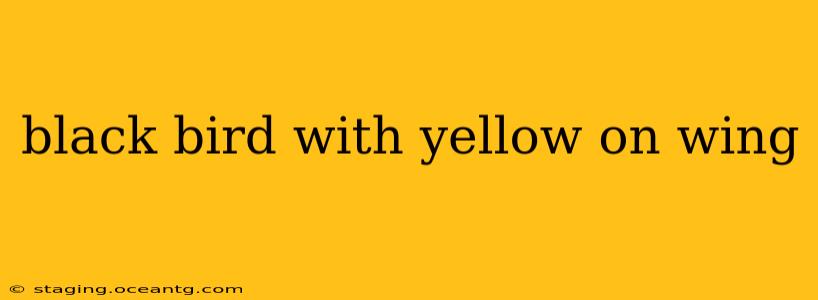Many bird species boast striking black plumage accented with vibrant yellow. Pinpointing the exact bird requires more information, but let's explore some likely candidates and the key features to look for in identifying these beautiful creatures. This guide will help you narrow down the possibilities and appreciate the diversity of the avian world.
What Kind of Black Bird Has Yellow on its Wings?
This is a great starting point, and the answer depends heavily on your location. Different regions host different bird species. To help me narrow it down, consider these questions:
- Where did you see the bird? (Country, state, even a general area like "near a lake" helps)
- What was the size of the bird? (Was it roughly the size of a robin, sparrow, or something larger?)
- What was the shape of the bird? (Long, slender, compact, etc.)
- What was the pattern of the yellow markings? (Were they bars, patches, or a solid area?)
- What was the bird doing? (Was it foraging, singing, flying?)
Common Black Birds with Yellow Accents: A Quick Look
Several birds fit this description, including:
- Yellow-winged Blackbird (Agelaius thilius): This is a strong contender. They are predominantly black, with a distinctive bright yellow wing patch that's easily visible in flight. They're found in parts of South America.
- Golden-winged Warbler (Vermivora chrysoptera): While not entirely black, the male has a striking black and white face and back, with bright yellow wings and shoulders. This is a smaller bird found in North America.
- Black-and-Yellow Grosbeak (Pheucticus chrysogaster): This species shows a more extensive yellow on the wings and body, alongside black markings. They're found across Central and South America.
What Are Some Other Birds That Might Look Similar?
It’s important to note that many birds can appear similar at a glance. Lighting conditions, distance, and the angle of observation can all affect how a bird appears. Consider these factors when making your identification:
- Age and Sex: Young birds often have different plumage than adult birds. Similarly, males and females can have quite different coloration.
- Habitat: The environment where you saw the bird provides vital clues. Does it prefer forests, grasslands, wetlands, or urban areas?
- Flight Pattern: How does the bird fly? Is it a fast, direct flight or a more erratic, fluttering style?
How Can I Identify the Bird More Accurately?
Using a reliable bird identification guide or app will be incredibly helpful. Many apps feature image recognition, making it easier to match your sighting to a specific species. Consider using apps such as Merlin Bird ID (Cornell Lab of Ornithology) or eBird.
What are the Best Resources for Bird Identification?
Beyond apps, field guides are invaluable resources. Look for guides specific to your region, as they will list the birds most likely to be found in your area. Websites and online forums dedicated to birding can also be helpful for comparing your sightings with others' observations.
What Else Could a Black Bird with Yellow on its Wings Be?
This question is best answered with more information about where you saw the bird and what other characteristics it possessed. The variability in bird appearances makes a definitive identification impossible without more details. The key is to gather as much information as possible and utilize reliable bird identification resources.
